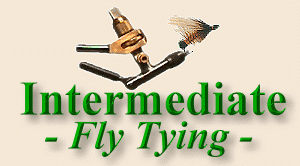Once again, I'm tying a type of fly that often uses hard to find
materials, but I'm using common materials you can easily find. I'm
rather fond of classic salmon flies because they are pretty and look
graceful just sitting in the vise. If you want a lot of praise from your
friends who don't tie flies, just tie up some salmon flies for them to
look at and you'll earn their respect.
I placed this fly in the fly vise case at work and immediately started
getting compliments from the viewers. The techniques used in tying the
fly aren't really difficult, but the fly looks difficult enough to the
average person to gain their attention. Heck, I won't tell them how easy
it really was if you don't.
This pattern is called a Tequila Sunrise because of the blend of colors
I use in it. Once upon a time when I was much younger and much more
foolish, I had a passion for the drink that uses the same name. It was a
pretty drink to look at, but it made me do ugly things, so I gave up on
the drink, but not the fly.
Being as landlocked as I am here in the middle of the continent, I don't
get many chances to fish for salmon. That hasn't prevented me from using
classic salmon fly patterns though. I've discovered that pike, bass and
large trout will also munch on salmon flies. Since they're fun to tie
and pretty to look at, all the nice looking flies go on display and the
ones that don't look so nice go fishing. I win twice that way.
If you live around gray squirrels and are handy with dye, you'll have
all the raw materials you need to tie up a bunch of these flies. If not,
the raw materials aren't very expensive, and are easily obtained from
many fly shops or by mail order. If you wish to substitute dyed calf
tail or synthetic hair, that's another option open to you. It's your fly
to tie as you wish.
Once again, I'm substituting a common feather (from the head of a
pheasant) for the more exotic jungle cock feathers used on many salmon
flies. This gives the fly a similar visual effect, but keeps the cost of
the materials low and the ease of finding them high. To the untrained
eye, it looks like exotic feathers used in the cheeks of the fly. Who's
going to tell on you? Certainly not me.
Since I've likely earned the title of heretic by now, I guess I'll
continue that thought with this fly. Join me in the heresy of tying a
simple but productive classic style salmon fly.
|




















